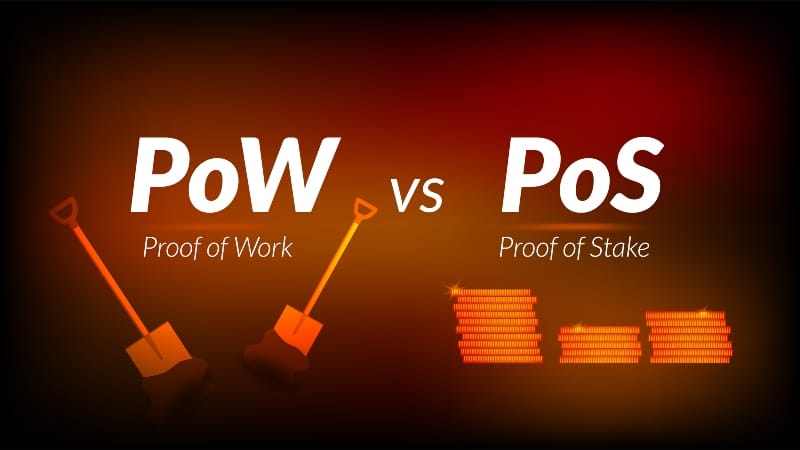What might happen if one day Bitcoin becomes PoS?

Bitcoin is a protocol that uses Proof-of-Work (PoW) as its consensus mechanism. This is a mechanism that involves significant power consumption that increases as the value of BTC rises, but at the same time, it guarantees the high immutability of its blockchain.
Other cryptocurrency protocols, on the other hand, use Proof-of-Stake (PoS) because it is a less energy-intensive mechanism and allows for faster block generation. It is, however, somewhat less secure than PoW.
For example, Ethereum was born with PoW, but then over the years decided to switch to PoS. Could something similar happen to Bitcoin?
Summary
- What if Bitcoin becomes a PoS system?
- The disadvantages of Proof of Stake
What if Bitcoin becomes a PoS system?
As of today, the answer is definitely no.
In fact, no one has the power to arbitrarily change the Bitcoin protocol, and right now there is not a large majority of Bitcoin users who would accept such a radical change to it.
To switch from PoW to PoS requires a complete change in the system by which blocks are created, so much so that, for example, Ethereum even had to create a new PoS-based blockchain, deciding to abandon the old PoW-based one once the final switch is made.
Perhaps, the conditional is a must, in the relatively distant future even for Bitcoin a strong majority of users could arise, who would approve of such a radical change, but as of today, we cannot even glimpse this scenario.
Moreover, although some argue that Bitcoin’s energy consumption will continue to increase at a high rate until the switch to PoS becomes necessary, in reality, however, in the long run, Bitcoin mining’s energy consumption is likely to go down, due to the continued halving of miner rewards once every 4 years.
That said, no one, however, forbids imagining purely theoretically what Bitcoin’s move to PoS might entail.
In reality, it is not that difficult. In fact, should the decision be made to replace PoW with PoS on Bitcoin as well, the process could even be very similar to that done by Ethereum.
However, PoW allows the block time, on which Bitcoin’s monetary policy depends, to be kept very constant over the years: a block is formed every 10 minutes or so, and a halving of the BTC in premium every 210,000 blocks, or just under 4 years. With PoS it may be more difficult to keep this monetary policy fixed and rigid.

The main findings on Bitcoin if it were to switch from PoW to PoS
The disadvantages of Proof of Stake
The move to PoS then would create significant differences between nodes with more BTC in staking and the others. Right now, however, Bitcoin’s 10,000 or so public nodes are all the same, all with the same power. PoS, on the other hand, inevitably leads some nodes to handle more tokens, in effect making them somewhat more “powerful.”
It would certainly make miners disappear since PoS does not involve mining. This would suddenly and dramatically reduce energy consumption, which is currently perhaps the single biggest problem for Bitcoin.
The fact that PoS turns out to give slightly less security than PoW, on the other hand, might not even be that significant, because the current level of security is so high that even a slightly lower degree perhaps could be considered tolerable.
Instead, the fact that PoS protocols are often less decentralized could be a problem for Bitcoin, for example, if a few large nodes with immense amounts of BTC immobilized in staking, and thus from great decision-making power, were to be formed.
Perhaps this is one of the main reasons why the majority of Bitcoin users do not want changes in the underlying protocol, because Bitcoin’s high degree of decentralization is precisely one of its greatest strengths, to be protected and maintained as much as possible.






 Bitcoin
Bitcoin  Ethereum
Ethereum  Tether
Tether  USDC
USDC  TRON
TRON  Dogecoin
Dogecoin  Cardano
Cardano  Bitcoin Cash
Bitcoin Cash  Chainlink
Chainlink  LEO Token
LEO Token  Stellar
Stellar  Monero
Monero  Litecoin
Litecoin  Hedera
Hedera  Zcash
Zcash  Dai
Dai  Cronos
Cronos  OKB
OKB  Tether Gold
Tether Gold  Ethereum Classic
Ethereum Classic  KuCoin
KuCoin  Gate
Gate  Algorand
Algorand  VeChain
VeChain  Cosmos Hub
Cosmos Hub  Dash
Dash  Stacks
Stacks  Tezos
Tezos  TrueUSD
TrueUSD  IOTA
IOTA  Basic Attention
Basic Attention  Decred
Decred  Theta Network
Theta Network  NEO
NEO  Synthetix
Synthetix  Qtum
Qtum  Ravencoin
Ravencoin  0x Protocol
0x Protocol  DigiByte
DigiByte  Zilliqa
Zilliqa  Nano
Nano  Siacoin
Siacoin  Numeraire
Numeraire  Waves
Waves  Ontology
Ontology  Status
Status  Enjin Coin
Enjin Coin  Pax Dollar
Pax Dollar  BUSD
BUSD  Hive
Hive  Lisk
Lisk  Steem
Steem  Huobi
Huobi  NEM
NEM  OMG Network
OMG Network  Augur
Augur  Bitcoin Gold
Bitcoin Gold  Ren
Ren  HUSD
HUSD